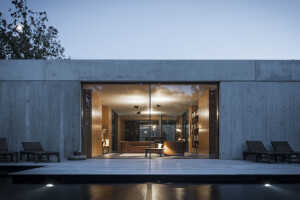Most striking is the brilliant Kirkland Museum cladding of glazed terracotta bars in four shades of yellow, punctuated by transparent glass “baguettes” backed with shimmering gold. Together, these elements sparkle in the sun, evoking the scenes from Vance Kirkland’s paintings. Additional glass elements were added in the form of hand-cast, amber-hued fins which project, louvre-like, perpendicular to the façade, framing the entrance. Further punctuating the walls are vitrines that serve both as a visually connection to the exterior and as display cases for additional artifacts, which can be seen both from inside and outside the museum.
More from the Architects:
Kirkland Museum of Fine & Decorative Art is a two-story museum in the heart of Denver’s arts and cultural district, the Golden Triangle. Located across the street from the Denver Art Museum and the Clyfford Still Museum, the new 38,000-square-foot museum has a bold presence. At the same time, it stays true to the intimate atmosphere for which Kirkland Museum is known, offering visitors an enhanced salon-like experience. Designed by architect Jim Olson, the new building highlights both the artistry and craft of Kirkland Museum’s internationally renowned decorative art collection and its singular collection of art by Colorado artists.
The museum is named for Colorado artist Vance Kirkland, whose historic studio building is part of the museum. Kirkland Museum’s collection comprises over 30,000 works, including the nation’s largest repository of Colorado art, and the International Decorative Art Collection, which is considered one of the most important design collections in North America. The new museum has 65% more gallery space than the previous building, with a total of thirteen galleries. While the elevations are calm and the layout is straightforward and easy to navigate, the materials cladding the exterior are full of energy. A key element of the design is a rich and vibrant façade inspired by the lively mix of art and craft in the collection. Luminous terracotta bars in an array of yellow hues, punctuated with rectangular glass “baguettes” backed in gold, enliven the building’s public face, sparkling in the bright Colorado sunlight, recalling the energy of a Vance Kirkland painting. A series of vitrines mounted onto the exterior of the building also showcase select objects from the museum’s collection, extending the galleries to the neighboring sidewalks and streets. Hand-crafted reddish glass “fins” delineating the museum entrance further enliven the façade. The building itself becomes a sparkling jewel box that expresses the vibrant examples of artistry and design housed within.
“Designing a new museum in Denver’s Golden Triangle near the Denver Art Museum and the Clyfford Still Museum is a great honor and a serious responsibility. My goal was to make an artistic statement that is uniquely appropriate to Kirkland Museum and inspired by its amazing collection.” ― Jim Olson, Design Principal
Project Team: Jim Olson, FAIA, Design Principal; Kirsten R. Murray, FAIA, Managing Principal; Crystal Coleman, LEED® AP, Project Manager; Daniel Ralls, Project Architect; Naomi Mason, IIDA, LEED® AP, Interior Design; Bryan Berkas, Motomi Kudo-King, Clay Anderson, Misun Gerrick, Jarri Hasnain, Martha Rogers, Project Staff
Contractor: Shaw Construction






































































